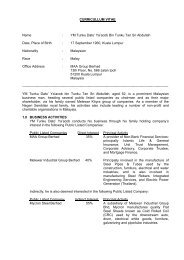Annual Report (Complete) - MYCRON Steel Berhad
Annual Report (Complete) - MYCRON Steel Berhad
Annual Report (Complete) - MYCRON Steel Berhad
Create successful ePaper yourself
Turn your PDF publications into a flip-book with our unique Google optimized e-Paper software.
Notes to the Financial Statements<br />
30 June 2010<br />
(continued)<br />
3. CRITICAL ACCOUNTING ESTIMATES AND JUDGEMENTS (continued)<br />
(e)<br />
Taxation<br />
Significant judgement is required in determining the provision for income taxes. These are transactions and calculations<br />
for which the ultimate tax determination is uncertain during the ordinary course of business. The Group recognises liabilities<br />
for tax based on estimates of assessment of the tax liability due. Differences which may arise from the final tax outcome<br />
and the amounts that were initially recorded will result in changes to the income tax and deferred tax provisions, where<br />
applicable, in the period in which such determination is made.<br />
(f)<br />
Deferred tax assets<br />
Deferred tax assets are recognised to the extent that it is probable that future taxable profit will be available against<br />
which the temporary differences can be utilised. This involves judgement regarding the future financial performance of the<br />
particular entity in which the deferred tax asset has been recognised.<br />
4. FINANCIAL RISK MANAGEMENT OBJECTIVES AND POLICIES<br />
The Group’s overall financial risk management objectives are to ensure that the Group creates value and maximises returns to its<br />
shareholders.<br />
Financial risk management is carried out through risk reviews, internal control systems, benchmarking the industry’s best practices<br />
and adherence to Group’s financial risk management policies.<br />
The main risks arising from the financial instruments of the Group are credit risk, interest rate risk, market risk, foreign currency<br />
exchange risk and liquidity and cash flow risk. The management of the Group monitors the financial position closely with an<br />
objective to minimise potential adverse effects on the financial performance of the Group. The Directors review and approve<br />
policies from managing each of these risks and they are summarised below. These policies have remained unchanged during<br />
the financial year.<br />
(a)<br />
Credit risk<br />
Credit risk arises when sales are made and services are rendered on deferred credit terms and when surplus cash is invested.<br />
The Group has credit policies in place to manage the credit risk exposure. The risk is managed through the application of the<br />
Group’s extensive credit management procedures which includes the application of credit evaluation, credit approvals<br />
and adherence to credit limits, credit periods, regular monitoring and follow up procedures.<br />
The Group does not have any significant exposure to any individual customer or counterparty nor does the Group have any<br />
major concentration of credit risk related to any financial instruments.<br />
Concentration of credit risk with respect to trade receivable is limited due to the Group’s nature of business which is<br />
predominantly cash based. The Group’s historical experience in collection of trade receivables falls within the recorded<br />
allowances. Due to these factors, no additional credit risk beyond amounts allowed for collection losses is inherent in the<br />
Group’s trade receivables.<br />
With regards to surplus cash, the Group invests its cash assets safely and profitably by depositing them with licensed financial<br />
institutions.<br />
The Group considers the risk of material loss from the non-performance on the part of a financial counter-party to be<br />
negligible.<br />
(b)<br />
Interest rate risk<br />
The Group and Company’s income and operating cash flows are substantially independent of changes in market interest<br />
rates. Interest rate exposure arises mainly from the Group’s borrowings and deposits with licensed bank.<br />
The Group manages its interest rate exposure by maintaining a prudent mix of fixed and floating rate borrowings.<br />
It is the policy of the Group not to trade in interest rate swap agreements.<br />
(c)<br />
Market risk<br />
The Group’s exposure to market risk arises mainly from changes in steel raw materials and finished goods prices. The<br />
management of the Group monitors the sales of finished goods and procurement of its raw materials closely to minimise<br />
the impact of market risk on the Group.<br />
(d)<br />
Foreign currency exchange risk<br />
The Group is exposed to foreign currency exchange risk as a result of transactions denominated in foreign currencies<br />
entered into by the Group.<br />
pg 63 | Mycron <strong>Steel</strong> <strong>Berhad</strong>











